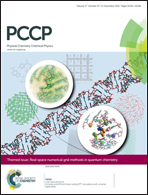Coupled phase field, heat conduction, and elastodynamic simulations of kinetic superheating and nanoscale melting of aluminum nanolayer irradiated by picosecond laser
Abstract
An advanced continuum model for nanoscale melting and kinetic superheating of an aluminum nanolayer irradiated by a picosecond laser is formulated. Barrierless nucleation of surface premelting and melting occurs, followed by a propagation of two solid–melt interfaces toward each other and their collision. For a slow heating rate of Q = 0.015 K ps−1 melting occurs at the equilibrium melting temperature under uniaxial strain conditions Tεeq = 898.1 K (i.e., below equilibrium melting temperature Teq = 933.67 K) and corresponding biaxial stresses, which relax during melting. For a high heating rate of Q = 0.99–84 K ps−1, melting occurs significantly above Teq. Surprisingly, an increase in heating rate leads to temperature reduction at the 3 nm wide moving interfaces due to fast absorption of the heat of fusion. A significant, rapid temperature drop (100–500 K, even below melting temperature) at the very end of melting is revealed, which is caused by the collision of two finite-width interfaces and accelerated melting in about the 5 nm zone. For Q = 25–84 K ps−1, standing elastic stress waves are observed in a solid with nodal points at the moving solid–melt interfaces, which, however, do not have a profound effect on melting time or temperatures. When surface melting is suppressed, barrierless bulk melting occurs in the entire sample, and elastodynamic effects are more important. Good correspondence with published, experimentally-determined melting time is found for a broad range of heating rates. Similar approaches can be applied to study various phase transformations in different materials and nanostructures under high heating rates.


 Please wait while we load your content...
Please wait while we load your content...